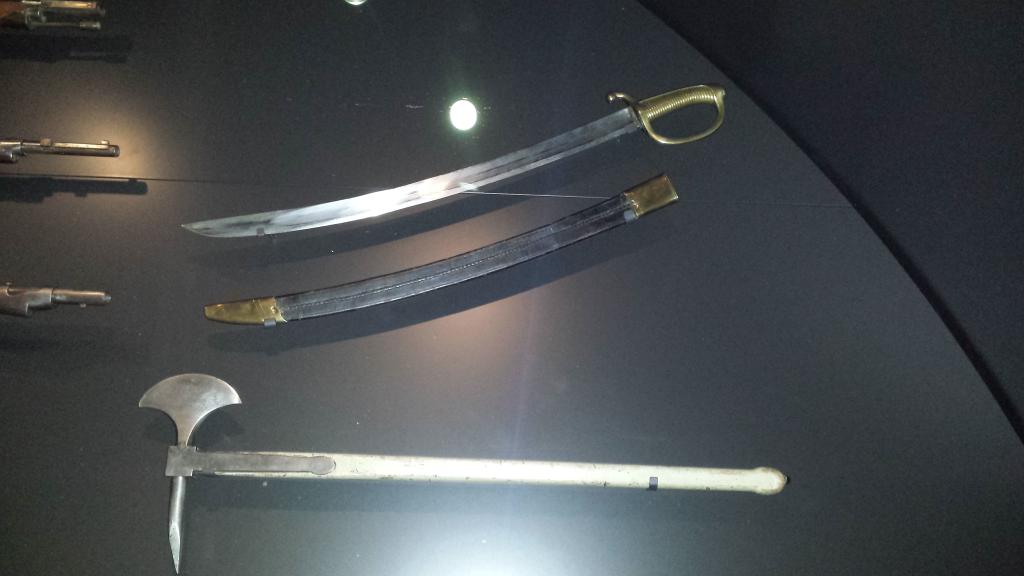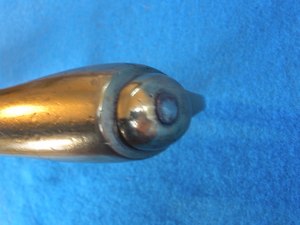For an infantry soldier who constantly has to march, counter-march, charge, having a overlong blade on a sword swinging from your hip that you weren't going to fight with anyway, would be a real pain. Especially when you have to carry a whole lot of other gear.
I haven't seen any mass-produced swords for foot soldiers with blades over 23 inches after the bayonet was adopted for mass infantry tactics. I feel that these 26-27 inchers are usually for some other purpose. For a NCO, or for a ships armoury, or (as sometimes was the case) a lower ranking officer who would wear a briquet hilt with a longer blade on it.
Last edited by Morgan Butler on Mon 12 Jan, 2015 10:38 am; edited 3 times in total
Thanks Jeroen! That's a very nice one. Straighter than mine....
| Jeroen T wrote: |
| Here is the picture from the Rijksmuseum in Amsterdam.
Like i said it was displayed in the naval section.  |
Well, that definitely looks similar.
Incidentally, I looked through my copy of May & Annis Swords for Sea Service last night. According to it, briquet-hilted cutlasses were quite common in European naval service in the early 19th century, most likely because the briquet was the most common infantry sabre and they were therefore plentiful and cheap.
(May & Annis noted that before 'regulation' cutlasses were introduced, many of these navies had used whatever pattern of brass-hilted infantry hangers had most recently been discarded by the local armies. In 1807, for example, when the Danish navy was scrambling for arms, the old grenadier hangers with heart-shaped shell guards were authorized for shipboard use, as was the Model 1802 Artillery sabre.)
May & Annis noted in particular that briquet-hilted cutlasses were used by the navies of Austria, Prussia, Russia, Denmark, Belgium and the Netherlands. While the dates of issue and periods of use obviously varied from navy to navy, in general, they were standard issue models from about 1805 to the 1850s.
What is very interesting is that the blade on our 'mystery briquet' turns out to be very very similar to the blade on the first regulation pattern sword used by the Dutch Navy, which was introduced in 1772. That sword had a curved sabre or hanger style blade, single-edged, with a single broad fuller and a very narrow ricasso. One of these swords is shown in the book - it is in the collection of the National Maritime Museum at Greenwich and was reputedly surrendered to Capt. William Bligh at the Battle of Camperdown in 1797. The blade on that particular sword is 27 3/4" long by 1 5/16" wide - quite close to the size of the blade on that briquet. Since the 1772 regulation sword pattern was officially replaced with a spadroon / smallsword style in 1795 (and then 1798 and 1808), it could be that any surplus 1772 sabre blades got used up on cutlasses.
| Quote: |
| Incidentally, I looked through my copy of May & Annis Swords for Sea Service last night. According to it, briquet-hilted cutlasses were quite common in European naval service in the early 19th century, most likely because the briquet was the most common infantry sabre and they were therefore plentiful and cheap. |
This is very much the bulk of my viewpoint but the trend as far back to the beginnings of cast brass hilts. Unmarked, the branch of military service must remain an open investigation. Gilkerson and Rakin reference the same thoughts.
Many officers and nco marched with the troops so the length issue is kind of a non sequitur. We also don't clearly have the data in front of us what was the standard across Europe for troopers and certainly not for officers and nco. I can agree many infantry swords did tend to fall into the 24"-25" range and that there might be an argument that racked naval swords were typically longer but it just ends in speculation. Many later nco swords were as short.. The broadest bladed European "French" type basket cutlass I have ever encountered proved to be Italian. I may have pictures somewhere, it was on a table at the Hartford Show
What does the peen look like? Can you share a picture?
Cheers
GC
"What is very interesting is that the blade on our 'mystery briquet' turns out to be very very similar to the blade on the first regulation pattern sword used by the Dutch Navy, which was introduced in 1772. That sword had a curved sabre or hanger style blade, single-edged, with a single broad fuller and a very narrow ricasso"
Interesting John. Thanks! If you can scan and post the pic from your book that would be great!
When I first decided (about 3 months ago) to acquire one of these longer, fullered briquet variants, I envisioned a sword like the one in Jeroens pic. I ended up with one that had more curvature, but it's in great shape and came at a great price.
Glen, the infantry briquets that I have come into contact with are usually 22-23 inches. Here's a pic of the peen!
 Attachment: 51.9 KB
Attachment: 51.9 KB

Interesting John. Thanks! If you can scan and post the pic from your book that would be great!
When I first decided (about 3 months ago) to acquire one of these longer, fullered briquet variants, I envisioned a sword like the one in Jeroens pic. I ended up with one that had more curvature, but it's in great shape and came at a great price.
Glen, the infantry briquets that I have come into contact with are usually 22-23 inches. Here's a pic of the peen!

Good looking peen on that Morgan and not likely a later composite. .
Cheers
GC
Cheers
GC
Another interesting briquet sword with unusual blade:
http://www.ebay.com/itm/Spanish-or-Italian-An...&rt=nc
http://www.ebay.com/itm/Spanish-or-Italian-An...&rt=nc
Glen: Glad to hear about the peen being original in your opinion. That was a question of mine.
Luka: Interesting. I just saw another briquet on ebay with a italian motto on it as well. Too bad the quillon's missing on this one. I think that would be an example of a briquet hilt being used by an officer. Here' another example:
http://www.swshana.com/sword_website/pages/6a.htm
Luka: Interesting. I just saw another briquet on ebay with a italian motto on it as well. Too bad the quillon's missing on this one. I think that would be an example of a briquet hilt being used by an officer. Here' another example:
http://www.swshana.com/sword_website/pages/6a.htm
Page 2 of 2
You cannot post new topics in this forumYou cannot reply to topics in this forum
You cannot edit your posts in this forum
You cannot delete your posts in this forum
You cannot vote in polls in this forum
You cannot attach files in this forum
You can download files in this forum
All contents © Copyright 2003-2006 myArmoury.com — All rights reserved
Discussion forums powered by phpBB © The phpBB Group
Switch to the Full-featured Version of the forum
Discussion forums powered by phpBB © The phpBB Group
Switch to the Full-featured Version of the forum